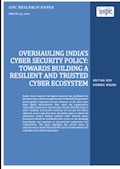DRDO’s Success with HSTDV: Hypersonic Missiles in Sight
India successfully tested an indigenously-developed hypersonic technology demonstrator vehicle (HSTDV) powered by a scramjet (supersonic-combustion ramjet) engine on September 07, 2020. This test is an essential step towards building next-generation hypersonic cruise missiles. The Defence Research and Development Organisation (DRDO) achieved a significant technological achievement when it flew a cruise vehicle at a hypersonic speed of Mach 6, for 20 seconds.
Understanding the Technology






